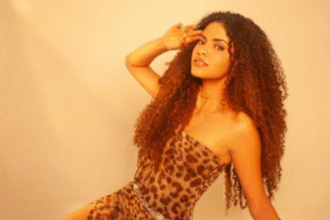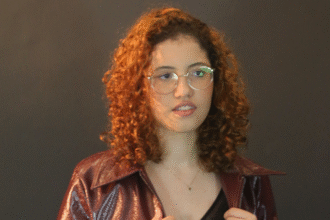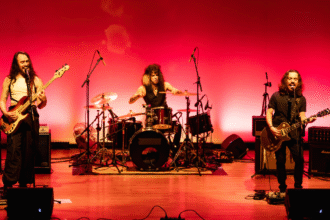The multi-artist Bia Nogueira is ready to delight her fans with the launch of her long-awaited album “Respira”. As a preview of the album, she released the single and clip “Pele”, which portray the intense moments that take your breath away. Inspired by lust, sexual tension and the desire to touch from a distance, the artist incorporates R&B elements into her poetry, with the participation of Bela Maria. The release is by the label A Quadrilha, by rapper Djonga, and the clip was directed by Vivih Zaza.
Bia Nogueira is recognized for her ability to mix different languages in her artistic work. Her musical style encompasses an engaging mix of electronic, pop, MPB and traditional Afromineira music, which she affectionately calls “Afrobeat de BH” or “Uaifrobeat”, in reference to the growing movement in Belo Horizonte.
Bia Nogueira’s new album, anticipated by the release of the single “Calma”, marks an evolution in the exploration of vocal timbres and sound composition. The artist has also been dedicated to creating clips and visualizers that combine digital and real elements, exploring the concept of the metaverse. This research will unfold in several actions within virtual reality. As proof of this quest for innovation, the video for “Pele” premiered at the digital festival IMuNe + Cidade Alta, reaching over 1 million views.
In addition to her musical career, Bia Nogueira works as a singer, actress, composer and cultural producer. She was one of the founders of Festival Sonora and Coletivo Mulheres Criando, two important platforms for valuing music made by women. Bia is also the creator and creative director of Festival Imune – Instante da Música Negra, in addition to being part of the band Yônika and Grupo dos Dez, a renowned theater company.
In 2020, Bia Nogueira had a special appearance on the album “Histórias da Minha Área”, by Djonga, on the track “O Cara de Óculos”. Over the past year, she has released eight videos with her Coletivo IMuNe, expanding her artistic reach even further.
Bia Nogueira’s trajectory also includes performances in theatrical shows and musical direction in the award-winning “Madame Satã”, by Grupo dos Dez. She has played the role of scenic director in musical presentations and has recently worked on the new show by A Quadrilha.
How did the inspiration for composing “Pele” come about and what is the main message conveyed by the song?
I wrote this song during the pandemic. There was a moment when I isolated myself in a small town and lived alone for three months to compose the songs for the album that I’m going to release in September. In fact, it was isolation also with the intention of curing me a little of the enormous sadness that I felt being isolated in an apartment in Belo Horizonte. I thought going into the woods would help me get better.
Anyway, this chorus and a part of the lyrics and melody of the stanzas appeared there, on a night when I felt this desire to be with someone. That unstoppable desire that I talk about in the song, that makes us tremble, but that couldn’t be fulfilled because the touch was, in a certain way, forbidden. The presence of another person was forbidden. We lived in isolation. Afterwards, I sent this unfinished material to Maíra Baldaia and she completed the song. I remember talking to her about this feeling of really wanting the presence of someone’s body and, instead, being able to have just one message. She came back with an amazing result. Many of us had to solve it ourselves, touching ourselves and killing ourselves, right? It’s a little bit about that too.
How was the partnership with the singer Bela Maria and how does your participation contribute to the song?
I was invited to Porto Musical, a music market conference that takes place in Recife. In addition to participating as a lecturer, I also introduced myself. It was May 2021, if I’m not mistaken, and we were resuming the shows, the live meetings of our musical ecosystem. Everything that happened there was very special because there was an aura of hope, solidarity and a lot of affection. We were all happy with the fact that we were able to return to the stage, to do our events again and to meet. So, the meetings that took place there were quite significant. That’s when I met Bela and her engaging voice, her remarkable presence. I kept her in mind and, some time later, I invited her to participate in the recording of the single and also sing at the event I hold, the Festival IMuNe.
The video for “Pele” was directed by Vivih Zaza. Can you tell us a little more about the collaboration and the idea behind the artistic direction of the video?´
Vivih Zazá is a sensitive and talented director. I met her during the pandemic, through Associação Lanternas Inspiradoras, whose main project aims to offer training in audiovisual and technology for young people in the interior of Minas Gerais. At that time, I was hired to implement the association’s cultural projects and she was one of those people who was graduating there and who went to specialize in São Paulo. She came back full of ideas, and she connected deeply with the album’s narrative. We spent hours and hours debating what each video would look like. She brought up the idea of bringing this couple into the narrative, of filming in a mansion, of being minimalist in the objects of the clip so that those beautiful black skins stood out in the scenery.

The theme of desire, sexual tension and intimacy experienced at a distance is addressed in the song. How do you think these elements relate to the digital age and contemporary society?
I think it’s a relationship full of contradictions. On the one hand, technology can bring us closer together, after all, there is a profusion of apps and social networks that aim to shorten geographical distances and facilitate communication. During the pandemic, for example, how many of us didn’t make that hottest video call to try to kill the urge to touch… lol
However, I believe that the excessive mediation of screens and hyperconnectivity can make people increasingly isolated in their homes. A very common image in our daily lives is that of a couple sitting opposite each other in a restaurant and each looking at their cell phone. I have a song on the album that talks about that…
The new single is part of the next album by Bia Nogueira, entitled “Respira”. What can fans expect from this album in terms of musical style and sound?
The album will bring a pop sound that dialogues with the present. But he also has his foot planted in the ancestral traditions of my black people from Minas Gerais. I have been doing aesthetic research for many years where I mix many of my musical references: the rhythms of congado from Minas Gerais, pop, MPB and electronic music. The congado, or Reinado as it is commonly called, is an Afro-Mineira manifestation that dates back to the colonial period. A religious manifestation that is strongly expressed through music. In addition to the drum, which we find in other black demonstrations throughout Brazil, we have two extraordinary percussive instruments that few people know outside Minas: the patangome and the gunga. The gunga is a kind of rattle attached to the foot. In order for it to be played, it must also be danced. It’s one of the most beautiful things I’ve ever seen. It is said that enslaved black people were transforming the noise made by the chains attached to their feet into music. There’s so much symbolism in that. Something that was made to imprison is resignified and transformed into an instrument that symbolizes very well this black force of resistance and our impressive musicality. I learned to play it a few years ago and I’ve been perfecting myself. In this new show of mine, the highlight is when I play the gunga. People are enchanted, just as I was when I saw Kátia Aracelle, a captain of the congado guard and actress, playing for the first time. Something that was made to imprison is resignified and transformed into an instrument that symbolizes very well this black force of resistance and our impressive musicality. I learned to play it a few years ago and I’ve been perfecting myself. In this new show of mine, the highlight is when I play the gunga. People are enchanted, just as I was when I saw Kátia Aracelle, a captain of the congado guard and actress, playing for the first time. Something that was made to imprison is resignified and transformed into an instrument that symbolizes very well this black force of resistance and our impressive musicality. I learned to play it a few years ago and I’ve been perfecting myself. In this new show of mine, the highlight is when I play the gunga. People are enchanted, just as I was when I saw Kátia Aracelle, a captain of the congado guard and actress, playing for the first time.
In addition to music, you mentioned that Bia Nogueira is exploring the metaverse and performing actions in virtual reality. Could you share more details about this research and how it connects with your art?
I am very interested in technology. It’s no wonder that I took the technical course in electronics at CEFET when I was a teenager and that during the period I was at the Faculty of Music at UFMG, I even took courses that made the intersection between music and technology.
During the pandemic, I started to get interested in digital art, NFT and metaverse, subjects that were starting to become popular, but that were kind of obscure for everyone. Coincidentally, I met Lohana Schalkken, who worked in the music department at Loud and she introduced me to Paulo Benetti from Cidade Alta. Loud is one of the largest e-sports organizations in Brazil and the world and Cidade Alta is the largest GTA RP server in Latin America. I was very impressed with the creative possibilities in the metaverse. We started to think together of a way to connect our stories, because I was preparing the program for Festival Imune, a black music event of which I am the creative director. I had already closed Djonga’s presence at the Festival and we started to freak out about doing something that would unite virtual reality and the real world. Because of all this, I bought a gaming computer and started playing Fortnite and following streamers who had characters in the Upper City. I even entered another server and created an avatar for myself and went to play with my character. I loved! I’m also an actress and theater director and for me it made perfect sense to be there because it’s like doing theater with the difference that it’s all improvised and your body is digital.
Together we held the IMuNe Festival in Cidade Alta. The World’s First Black Music Festival in the Metaverse. It was a hybrid experience because we had performances with the characters singing live, I even performed. We held a battle of MCs and I even made an exclusive pre-release of the PELE clip there in that metaverse. We also took part of the concerts that took place live at the Festival Imune into Cidade Alta on a screen inside a space created exclusively for the festival within the City.
Because of this whole story, I’m working on the visual part by integrating my avatar into the aesthetics of the work. The two covers of the singles that have already been released are of my avatar, my version of the metaverse created by the renowned artist of digital photography, Paulo Abreu. And this virtual and real relationship will only deepen from now on. We have some surprises going forward in this regard.

The video for “Pele” was presented at the digital festival IMuNe + Cidade Alta, with a large number of views. How has the public reception been towards the release of the single and your work in general?
I’m getting a lot of incredible feedback from the public, with a lot of people getting involved, sharing the work and connecting with the music. I think that many people recognize themselves in these lyrics, in this theme that I bring in Pele.
Regarding the work in general, I feel that we are making progress, because it is the first time that I have a partnership with a label and it makes a lot of difference. Last year I signed with A Quadrilha, a label belonging to Djonga. It is the first time that I work with support from a larger team that is involved in all stages. After the release of the first single from this project, we were able to tour some festivals in Brazil and ended 2022 with a tour of the North and Northeast. We already have an agenda confirmed by the midstream circuit in some capitals. This makes me very happy because it is a sign that the work is getting further. I think BH has a very powerful scene and this ends up strengthening the individual artists a lot.
In addition to her musical career, Bia Nogueira also works in musical theater and is involved in cultural projects. How do you balance all these different artistic expressions in your professional life?
I’m a Gemini…hahahahaha…for me it makes perfect sense to do what I do, how I do it. I connect everything, I create an internal script, a narrative where all the points intersect. I am a versatile person and this is expressed in my art. I don’t see any difference between making a song, putting on a show, thinking about curating a Festival or directing a show. It’s all about the creative process. But I confess that lately I’ve overdone myself and I ended up realizing that I need to do less things to not get sick. During the pandemic, I needed to slow down and I realized that the creative processes are much deeper when you have time to mature the stages.
How would you describe the sound of “Afrobeat de BH” and what is the role of this movement in the Belo Horizonte music scene?
I believe that there is still an incipient movement, not organized but very pulsating. Several artists are interested in this mix of MG’s afrodiasporic rhythms with the beats. In the capital, there is a very rich peripheral electronic music, proof of this is this phenomenon that became funk in BH. We have very talented djs standing out, like Vhoor and many others. At the same time, countless black artists are releasing works that bring this amalgamation between congado, electronic music, pop, funk and peripheral urban music as a whole, as is the case of Maíra Baldaia, Sérgio Pererê, Barulhista, Alysson Salvador, Raphael Salles, Josy Anne and Coletivo Imune itself, which released 8 singles in 2020 through Natura Musical. In this series of releases, we were investigating precisely this intersection.

What are the next steps in Bia Nogueira’s career after the release of “Pele”? Can we expect more releases, live performances or special projects?
This year, in September, we finally released the album RESPIRA by the label A Quadrilha. Before that, I’m going to release a remix and, starting in June, I’ll start to circulate with the show. We are preparing a show that is a mixture of languages and present technology, of course. I’m excited and I hope the audience goes on board with us.
Follow Bia Nogueira on Instagram





